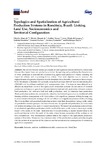Use este identificador para citar ou linkar para este item:
http://www.alice.cnptia.embrapa.br/alice/handle/doc/1047924| Título: | Typologies and spatialization of agricultural production systems in Rondônia, Brazil: linking land use, socioeconomics and territorial configuration. |
| Autoria: | ALMEIDA, C.  MOURÃO JUNIOR, M.   DESSAY, N.   LACQUES, A.-E.   MONTEIRO, A.   DURIEUX, L.   VENTURIERI, A.   SEYLER, F.   |
| Afiliação: | Cláudio Almeida, INPE; MOISES CORDEIRO MOURAO DE O JUNIOR, CPATU; Nadine Dessay, Institut de Recherche pour le Développement - IRD; Anne-Elisabeth Lacques, Institut de Recherche pour le Développement - IRD; ANTONIO MONTEIRO, INPE; Laurent Durieux, Institut de Recherche pour le Développement - IRD; ADRIANO VENTURIERI, CPATU; Frédérique Seyler, Institut de Recherche pour le Développement - IRD. |
| Ano de publicação: | 2016 |
| Referência: | Land, v. 5, n. 2, article 18, 2016. |
| Conteúdo: | The current Amazon landscape consists of heterogeneous mosaics formed by interactions between the original forest and productive activities. Recognizing and quantifying the characteristics of these landscapes is essential for understanding agricultural production chains, assessing the impact of policies, and in planning future actions. Our main objective was to construct the regionalization of agricultural production for Rondônia State (Brazilian Amazon) at the municipal level. We adopted a decision tree approach, using land use maps derived from remote sensing data (PRODES and TerraClass) combined with socioeconomic data. The decision trees allowed us to allocate municipalities to one of five agricultural production systems: (i) coexistence of livestock production and intensive agriculture; (ii) semi-intensive beef and milk production; (iii) semi-intensive beef production; (iv) intensive beef and milk production, and; (v) intensive beef production. These production systems are, respectively, linked to mechanized agriculture (i), traditional cattle farming with low management, with (ii) or without (iii) a significant presence of dairy farming, and to more intensive livestock farming with (iv) or without (v) a significant presence of dairy farming. The municipalities and associated production systems were then characterized using a wide variety of quantitative metrics grouped into four dimensions: (i) agricultural production; (ii) economics; (iii) territorial configuration, and; (iv) social characteristics. We found that production systems linked to mechanized agriculture predominate in the south of the state, while intensive farming is mainly found in the center of the state. Semi-intensive livestock farming is mainly located close to the southwest frontier and in the north of the state, where human occupation of the territory is not fully consolidated. This distributional pattern reflects the origins of the agricultural production system of Rondônia. Moreover, the characterization of the production systems provides insights into the pattern of occupation of the Amazon and the socioeconomic consequences of continuing agricultural expansion. |
| Thesagro: | Uso da Terra |
| NAL Thesaurus: | Amazonia |
| Palavras-chave: | TerraClass Socioeconomia Rondônia |
| Digital Object Identifier: | 10.3390/land5020018 |
| Tipo do material: | Artigo de periódico |
| Acesso: | openAccess |
| Aparece nas coleções: | Artigo em periódico indexado (CPATU)  |
Arquivos associados a este item:
| Arquivo | Descrição | Tamanho | Formato | |
|---|---|---|---|---|
| land.pdf | 3,44 MB | Adobe PDF |  Visualizar/Abrir |









